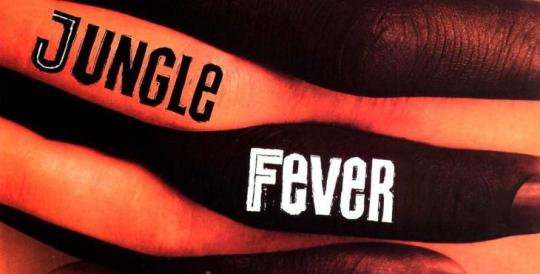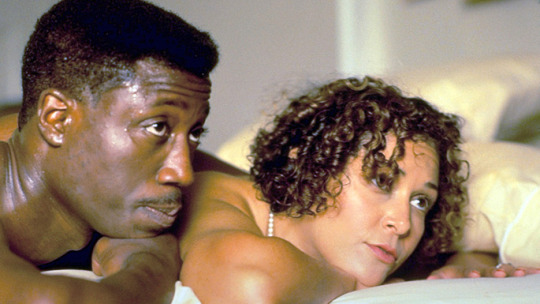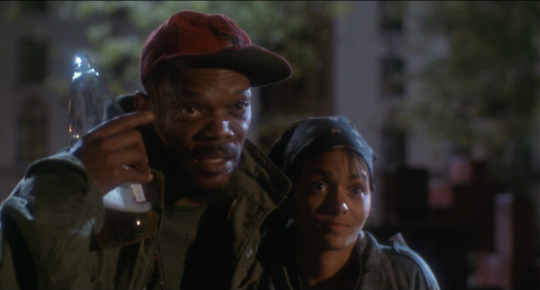With ‘Jungle Fever,’ Spike Lee Brought Cultural Taboos to A Theater Near You By Scott Tobias
By Yasmina Tawil

“Agree or war has been our way of compromising/ Let live and love has become our greatest lie.”
—Stevie Wonder, “Feeding Off the Love of the Land”
Toward the middle of Spike Lee’s Jungle Fever, a group of black women—a “war counsel,” as Lee’s character, Cyrus, jokingly refers to them—gather together to drink wine and sift through the remains of a broken relationship. Their friend and host, Drew (Lonette McKee), has kicked her husband, Flipper (Wesley Snipes), out of their tony Harlem brownstone for having an affair with Angie (Annabella Sciorra), an Italian temp at his architectural firm. Drew’s friends dutifully decry the evils that men do (“They’re all dogs”), but the conversation gradually shifts and expands, as conversations do, into more unexpected and compelling areas. Among the topics on the table: The finite number of good black men and the “white bitches” who throw themselves at them; the hang-ups men have with professional women; dating proclivities (“I’m not the rainbow-fucking kind”); the twin stigmas of light and dark skin; and the difficulties of sustaining a committed relationship.
“You know something, though?” Drew sighs ruefully at the end of it. “It doesn’t matter what color she is. My man is gone.”
Let us appreciate, for a moment, that 25 years ago, an American studio paid for this conversation and brought it to theaters nationwide. Having scored a hit with Lee’s galvanizing Do the Right Thing two years earlier—and bankrolled the somewhat less sensational Mo’ Better Blues the year after that—Universal Pictures recognized the director’s value as a frugal provocateur at a time when studios were more inclined to make small gambles. Lee’s sensibility hasn’t changed much in years since, but the landscape has shifted dramatically: His last two films, Da Sweet Blood of Jesus and Chi-Raq, have emerged from Internet pipelines—Kickstarter and Amazon Studios, respectively—that didn’t exist until recently and would have been completely inconceivable in 1991. But along with what could euphemistically be called Lee’s return to his independent roots come the consequences of limited exposure. To varying degrees, Da Sweet Blood of Jesus and Chi-Raq got batted around in the press and in big-city arthouses; Jungle Fever was now-playing-at-a-theater-near-you.

Consider the implications: It’s one thing to bring New Yorkers into Drew’s living room, where moviegoers are keenly aware of the cultural taboos and terrain, but it’s quite another to venture into the multiplexes of Missoula, Montana or Kennesaw, Georgia (where I saw the film) and be confronted by characters and problems of an uncommon complexion. In the suburbs and small towns, white Americans had spent the previous decade imagining the city as a war zone for Charles Bronson to bust up or the scary place the Griswalds drove through on their way to Walley World. With a film like Jungle Fever, Lee could upend assumptions simply by virtue of opening his mouth and describing the world as he understands it. A Romeo & Juliet affair between a black man from Harlem and a white woman from Bensonhurst? The varying burdens of skin pigmentation? The magisterial squalor of an inner-city crack den? For many, he was making foreign films without subtitles.
Jungle Fever doesn’t rank among Lee’s best films, and for good reason: It’s unfocused and undisciplined, applying the slice-of-life looseness of Do the Right Thing to a more conventional narrative that doesn’t accommodate it; the soundtrack, by Stevie Wonder, is half-inspired and half-incongruous; and the last shot may be the single worst of his career. But it has the virtue of candor, which is every bit as rare and precious now as it was when Lee’s career was in its infancy. To watch Jungle Fever in 2016 is to be aware of how far mainstream movies have retreated from anything remotely controversial, and how audiences, in turn, recoil when confronted with ideas that don’t affirm their own.

Lee opens Jungle Fever with Flipper and Drew making love in the soft light of the morning, with their daughter hearing them (and giggling) through the walls. From that idyllic picture of family togetherness and hard-won upward mobility, Lee cuts to the forces threatening to undermine it. At work, Flipper’s requests for an African-American secretary are ignored in favor of a temp-tress in Angie, and his ambition to become a full partner at the firm is rejected by his “colorblind” white bosses. During an after-hours session, Flipper and Angie flirt themselves into an affair that surprises them both: Flipper, happily married, has never cheated on his wife, and Angie is still stringing along Paulie Carbone (John Turturro), a sweet shopkeep who’s been infatuated with her forever.
They each confide in gossips—who, it should be noted, may have kept their secret if they didn’t disapprove of interracial relationships—and the fallout is swift and brutal: Drew throws Flipper out of the house, and his religious father (Ossie Davis) hits him with Old Testament wrath, and Angie’s father and brothers, who expect dinner from her every night, treat her more brutally still. Flipper and Angie get an apartment together, but there’s almost literally nothing to move in—they’re sharing a month-to-month lease in exile.

Lee includes a subplot involving Flipper’s crackhead brother Gator (Samuel L. Jackson) that wouldn’t belong in a more conventional movie and probably doesn’t belong here, either. The contrast between the siblings is drawn sharply enough to show how two destinies can diverge from the same place—and the last shot, misjudged as it is, reinforces Flipper’s (and perhaps Lee’s) worries about how easily a young life can stray off course. But the true purpose of the crack subplot in Jungle Fever is analogous to the presence of 9/11 in his great 2002 film 25th Hour: It’s something that was happening in his city and Lee felt compelled to document it. Whether it fits into the narrative or not isn’t entirely the point, because in 1991, audiences got a tour through “the Taj Mahal,” a sprawling cathedral of human history. And now, a quarter-century later, we have a time capsule of an epidemic, all because Lee’s a documentarian as much as a dramatist.

The Gator subplot takes away from Flipper and Angie’s relationship, nearly to the point where they become supporting characters in their own story, but the die has been cast. A relationship founded on little more than fleeting sexual chemistry cannot possibly withstand the cultural pressure that bears down it from Harlem and (especially) Bensonhurst. It’s a Romeo-and-Juliet scenario where Romeo and Juliet don’t love each other and are merely partners in rejection. Lee speculates about why they’re together, but doesn’t come out with any clear answers: Flipper admits to being curious about Angie’s whiteness, but she seems motivated by good old-fashioned loneliness and attraction, and perhaps the opportunity to advance to a better station than temping and babysitting three grown men.
Though Jungle Fever broaches a taboo subject, Lee doesn’t draw any hard conclusions about it. If anything, he seeks to celebrate the potential of interracial partnerships, contrasting Flipper and Angie’s disastrous affair with Paulie’s tentative courtship of an African-American customer (Tyra Ferrell) who frequents his shop. Flipper’s problems are mostly self-inflicted, tied to infidelity and the needless wreckage that makes of a good life; there’s a decency to Paulie that may lead him to the other side. But the purpose of Jungle Fever isn’t to cast judgment on interracial relationships so much as to reveal that society isn’t over its hang-ups about them—whether those hang-ups lie in more nuanced issues of black identity or the straight-up racism Angie encounters in Bensonhurst. Lee wants viewers to know that these hang-ups exists, whether they choose to acknowledge them or not. He’s always the first to call attention to the elephant in the room.


